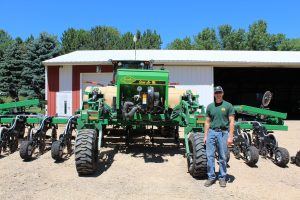
Keith Hartmann used a Conservation Innovation Grant from MCGA to modify this piece of equipment that allows him to plant cover crops while side-dressing nitrogen fertilizer.
Written by Nicole Krumrie, MCGA intern
When some people think of scientists, they think of someone wearing goggles and a white lab coat. When some think about a farmer, they tend to think of an older man wearing jean coveralls and a straw hat with a piece of hay hanging out of his mouth.
What many don’t consider is that a farmer is a scientist in their field every day. This past week, I had the chance to visit two farms in Minnesota that received funds through the Minnesota Corn Growers Association Conservation Innovation Grant Program. Keith Hartmann, Brad Nere, and Kyle VanOverbeke have all been creating machinery on their farms to test the effectiveness of cover crops. These cover crops will protect water quality, increase soil fertility, and water movement beneath the soil.
Keith Hartmann
Keith Hartmann from Gibbon, Minn., loves to grow crops. “I am passionate about seeing green on the field, he said.” That passion inspired him to grow cover crops in his fields. This year, he developed an intraseeder that applies liquid nitrogen fertilizer while also planting cover crops between his corn rows. He interseeded 120 acres of corn with cover crops. He used a mix of grasses and radishes. To plant one acre, Keith would need 10 pounds of seed at about $15 an acre.
Equipment was the biggest challenge according to Hartmann. “Figuring out the best set up for my equipment with clearance has been a work in progress. I have come up with some problems while planting my cover crops this year, and I will have to assess them next year.”
Something that really surprised Hartmann was the earth worm population in soil because of the cover crops he planted. The earthworms add to the richness and healthiness of Hartmann’s soil. “The soil smelled very rich where the roots were growing…it was really eye opening.”
Hartmann adds there is a weather value to adding cover crops within his corn rows. When it rains, the crops absorb all the water to avoid water pooling in parts of the field. Hartman stated a concern with farmers in his area is that the cover crops would compete with the corn during a time of drought. According to Hartmann that fear is a common misconception with farmers. “During a time of drought, the cover crops will be the first to wilt and die before the corn.”
Brad Nere and Kyle VanOverbeke
Brad Nere, along with his son-in-law Kyle VanOverbeke, have also worked to create an intraseeder to apply cover crops in-between the crop rows. Nere and VanOverbeke, of Danube, Minn, have been using cover crops for four years, and are still determining what mix of cover crops and timing of seeding works on their farm. “People think we’re crazy for trying to use cover crops and I hear it all the time,” Nere said.
After harvest, Nere and VanOverbeke plan to fence off parts of their field to allow their beef cattle to graze on the cover crops that remain on the field. This year, the two have spent around $18-$20 per acre on the 400 acres of crops that they planted in cover crops. Allowing the cattle to graze on the cover crops will offset some feed cost.
Some of the challenges for Nere and VanOverbeke were dealing with cover crops that lasted over winter and off/on germination with aerial application. There were a few surprises for Nere and VanOverbeke. They had success while interseeding during the V6 growth stage (the sixth leaf has grown and the growing point is about the surface) and they have also received better yields since interseeding with cover crops.
The two will use the results they collected this year to better implement cover crops on their fields next year. VanOverbeke said, “We really like the flexibility of trying new things to determine what works best on our farm.”
These farmers are working hard in their field, as scientists, to determine how to best plant cover crops. Cover crops are a great option to protect water quality, increase soil fertility, and water movement beneath the soil. Stay tuned for information about other innovation projects that we will cover at MinnesotaCornerstone.com. We will also be featuring some more information how you can apply for a MCGA Conservation Innovation Grant at FarmFest!

